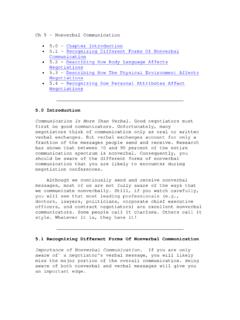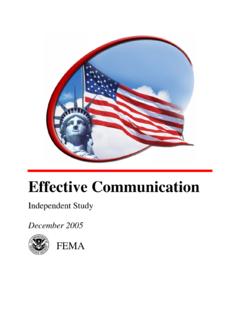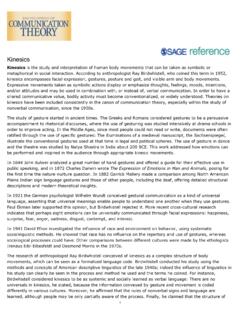Transcription of NoN-Verbal CommuNiCatioN - World Bank
1 NoN-Verbal CommuNiCatioN | CommGAP NoN-Verbal CommuNiCatioNHow Do You Define NoN-Verbal CommuNiCatioN ? CommuNiCatioN is generally defined as has having both a verbal and nonverbal component. Whereas ver-bal CommuNiCatioN often refers to the words we use in CommuNiCatioN , nonverbal CommuNiCatioN refers to CommuNiCatioN that is produced by some means other than words (eye contact, body language, or vocal cues, for example) (Knapp & Hall, 2002).1 The five primary functions of nonverbal Behavior (Argyle, 1988)are:21. Expression of Emotion emotions are expressed mainly through the face, body, and CommuNiCatioN of Interpersonal Attitudes the establishment and maintenance of relationships if often done through nonverbal signals (tone of voice, gaze, touch, etc.)
2 3. Accompany and Support Speech vocalization and nonverbal behaviors are synchronized with speech in conversation (nodding one s head or using phrases like uh-huh when another is talking).4. Self-Presentation presenting oneself to another through nonverbal attributes like Rituals the use of greetings, handshakes or other Dimensions of nonverbal CommuNiCatioN Physical appearance Appearance messages are generally the first nonverbal messages received and can be used to develop judgments about people based on how they look, what they wear, and their level of attractiveness, among other things (Virginia P. Richmond & McCroskey, 2004).3 Physical attractiveness impacts how people perceive others as similar to themselves and is used to evaluate credibility and general attractiveness (Hickson III & Stacks, 1993).
3 4 territory and Personal Space (Proxemics) Personal space refers to the space an individual maintains around him or herself, while territory is a larger area an individual controls that can provide privacy (for example, an office or a specific chair in the conference room). Invading another s territory may cause that person discomfort and the desire to defend his or her space (by turning away or creat-ing a barrier, for example) (Argyle, 1988).2 Culture can influence the way that individuals use space. Individualist societies like the United States emphasize personal rights and responsibilities, privacy, and freedom, whereas more collectivist societies emphasize community and collaboration (Andersen, Hecht, Hoobler, & Smallwood, 2002).
4 5 1 Knapp, M. L., & Hall, J. A. (2002). nonverbal CommuNiCatioN in Human Interaction. Crawfordsville, IN: Thomson Learning. 2 Argyle, M. (1988). Bodily CommuNiCatioN , 2nd ed. New York, NY: Methuen. 3 Richmond, V. P., & McCroskey, J. C. (2004). nonverbal Behavior in Interpersonal Relations. Boston, MA: Allyn and Bacon/Pearson Education. 4 Hickson III, M. L., & Stacks, D. W. (1993). NVC nonverbal CommuNiCatioN Studies and Applications. Dubuque, IA: Wm C. Brown Communications. 5 Andersen, P. A., Hecht, M. L., Hoobler, G. D., & Smallwood, M. (2002). nonverbal CommuNiCatioN across cultures. In W. B. Gun-dykunst & B. Moody (Eds.), Handbook of International and Intercultural CommuNiCatioN .
5 Thousand Oaks, CA: CommuNiCatioN | CommGAP | 2 Facial expressions The most important NoN-Verbal channel for expressing attitudes and emotions to other people is the face (Argyle, 1988).2 Researchers have attempted to categorize facial expres-sions that express emotion and typically agree on six: happiness, surprise, fear, sadness, anger, dis-gust/contempt. (Ekman, 1982 cited by Argyle, 1988).6 Gestures & Posture Gestures and postures are frequent and continuous movements of the body that reflect individual thought processes and regulate CommuNiCatioN (Goldman, 1994).7 For body language to be interpreted as positive and genuine, it is important that it appear to be natural.
6 Lewis (1998)8 suggests individuals stand erect and walk with shoulders back and stomach in. This helps communicate a message of self-confidence, awareness, and enthusiasm. touch (tactile CommuNiCatioN ) Argyle (1988)2 writes that the most basic meaning of touch is that an interpersonal bond is being offered or established (p. 226). While touch can be used for consolation, support, and congratulations depending on the relationship, touch is often culturally regu-lated in organizations (Harris, 2002)9 meaning it may be regulated to behaviors such as handshakes. Touch, like any other CommuNiCatioN message, may elicit negative and positive reactions depending on the configuration of people and the circumstances (Knapp and Hall, 2002).
7 1 eye Contact Eye contact regulates conversation and signals the exchange of speaker and listener roles. It is occurs during 10 30% of the conversation. Eye contact is used to acknowledge or avoid the presence of others and can reveal information about attitudes, emotion, dominance and power in social relationships. When there are breakdowns in conversation it may be because the people con-versing have different patterns of eye contact (which can be a result of differing cultural backgrounds). When individuals respond with their eyes they allow others to have a sense of their emotional state and can increase feelings of CommuNiCatioN satisfaction (Webbink, 1986).
8 10 Vocal Cues that accompany Speech (Paralanguage) Vocal cues include intonation, voice qual-ity and vocal emphasis and that can enhance verbal meaning. Laughing and crying are also considered vocal cues. These cues may reveal an emotional state, attitudes towards others, social class, or origin. Individuals may exercise dominance with a loud projecting voice and indicate submission by using a lower, softer pitch. When communicating verbally it is important to ensure that the paralanguage aligns with the verbal messages it accompanies (Lewis, 1998).7 time (Chronemics) The way an individual talks about or uses time can communicate much NoN-Verbal information about him or her.
9 Individuals may view time as the location or duration of events, the interval between events, or as patterns of intervals (routines or cycles of behavior) (Knapp & Hall, 2002).1 Individuals may also have differing psychological time orientations that influence how they think about and perceive time in their daily lives. Individuals may be more past-oriented, using the past to shape the present, or future-oriented, working towards tomorrow. Individuals can also be present-oriented, living mostly for today. Culture can play a role in determining time orientation, so it is important to be aware of these differences and their potential impact on CommuNiCatioN (Virginia P.)
10 Richmond & McCroskey, 2004).3 6 Ekman, P. (1982). Emotion in the Human Face, 2nd ed. Cambridge: Cambridge University Press. 7 Goldman, E. (1994). As Others See Us. New York, NY: Routledge. 8 Lewis, H. (1998). Body Language: A Guide for Professionals. Thousand Oaks, CA: Sage. 9 Harris, T. E. (2002). Applied Organizational CommuNiCatioN : Principles and Pragmatics for Future Practice. Mahwah, NJ: Lawrence Erlbaum Association. 10 Webbink, P. (1986). The Power of Eyes. New York, NY: Springer CommuNiCatioN | CommGAP | 3 Selected Principles of nonverbal CommuNiCatioN in organizations (as cited by Harris, 2002)8 People judge relationship quality through nonverbal cues (Hickson & Stacks, 1985; Remland, 2000).

















